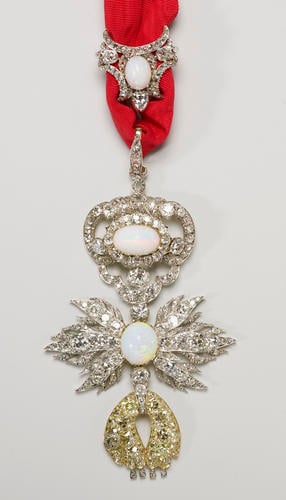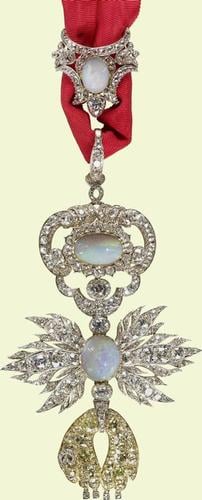-
1 of 253523 objects
Badge of the Order of the Golden Fleece c. 1810
Gold, silver, yellow and white diamonds and opals | 14 x 7.5 cm (fleece) (whole object) | RCIN 441170
-
The Golden Fleece was the first foreign order received by Prince Albert after his marriage. The orders he had received earlier were from relatives, but after February 1840 the acceptance of any award - even from a relative - could be deemed a political gesture favouring a particular state, with implications for British foreign policy. Honours which would have been offered to the Queen by foreign sovereigns and governments had she been male were unavailable to her, and so the Prince was given orders that she could not be offered. This brought with it concerns on the part of both the Queen and the Prince that reciprocation would invariably be assumed. The offer of the Golden Fleece to the Prince in 1841 by the Regency government of Spain, on behalf of the 11-year-old Queen Isabella II, epitomised these problems. After much diplomatic negotiation, it was agreed that the Prince would accept the Order and would be invested by the Duke of Wellington, acting as Isabella’s proxy in his position as a Grandee of Spain and a Knight of the Golden Fleece. The Queen wrote to King Leopold, describing the ceremony of 27 April 1841:
Albert has rec’d the Golden Fleece; … he was invested by the Duke of Wellington, whom the Regency had charged as Grandee of Spain and having the Order, to present it to him. The old Duke and Alva [the Spanish Ambassador] … were delighted at this, & the old Duke … appeared in a new Spanish Uniform made for the occasion.
The original badges of the Golden Fleece featured the Order’s symbol, a ram’s fleece - an allusion to the Burgundian wool trade as well as to the Golden Fleece of Greek mythology - hanging from a shower of sparks or flames emanating from a flint being struck by a fire steel (or briquette). By the nineteenth century the separate elements had become stylised and in Prince Albert’s badge the opals form the centre of the ‘briquette’ and the ‘flint’. The light, original setting of this badge has been adapted to take the opals in the slide, flint and sparks - particularly the middle stone in the flint. The incongruity of this later setting suggests that it may have been adapted from an earlier one. Just as the Prince’s Garter badge was an earlier piece reset for the Queen in 1840, it is possible that this was once the ‘Golden Fleece in brilliants’ sold to Rundell, Bridge & Co. in 1830. Opals were the Prince’s favourite stones (Journal, 4 July 1866). This and a second badge of the Order were the badges of foreign orders most often worn by the Prince. The opal badge can be seen in his portrait by Winterhalter of 1842 and in photographs by Fenton.
Text adapted from Victoria & Albert: Art & Love, London, 2010Provenance
Commissioned by Queen Victoria and presented to Prince Albert on his birthday, 1841
-
Creator(s)
Acquirer(s)
-
Medium and techniques
Gold, silver, yellow and white diamonds and opals
Measurements
14 x 7.5 cm (fleece) (whole object)
3.4 x 3.2 cm (silde) (whole object)
Other number(s)
Alternative title(s)
Order of the Golden Fleece; Badge of Prince Albert

